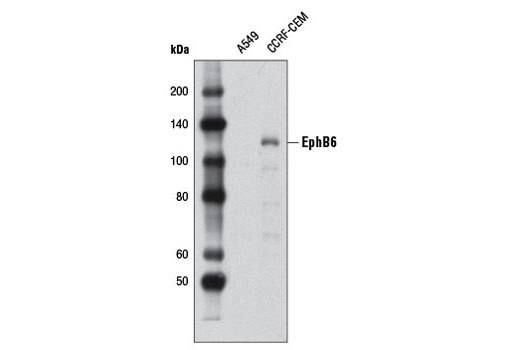WB, IP
H
Endogenous
125
Rabbit
#O15197
2051
Product Information
Product Usage Information
| Application | Dilution |
|---|---|
| Western Blotting | 1:1000 |
| Immunoprecipitation | 1:100 |
Storage
Specificity / Sensitivity
Species Reactivity:
Human
Source / Purification
Polyclonal antibodies are produced by immunizing animals with a synthetic peptide corresponding to residues surrounding Ala927 of human EphB6 protein. Antibodies are purified by protein A and peptide affinity chromatography.
Background
EphB6 is a kinase-defective receptor and member of the ephrin-B family of transmembrane proteins (1). Although lacking kinase activity, EphB6 can regulate cellular functions through its interaction with adaptor proteins and other Eph family members (2). In hematopoietic cells, EphB6 is specifically expressed in the T cell population (3) and functions as an important regulator of T cell receptor (TCR) mediated signaling. Upon binding with its ephrin-B1 or ephrin-B2 ligand, EphB6 modulates TCR activity through inhibition of JNK signaling, reduction of CD25 expression, and decreased IL-2 secretion (4). Reduced levels of cell proliferation and cytokine secretion are seen in EphB6 knock-out mice relative to wild type (5). In conjunction with EphB3 receptor activation, EphB6 suppresses Fas receptor induced apoptosis by triggering the Akt activation pathway (6). Research indicates that decreased EphB6 expression is associated with a higher degree of metastasis in various cancers, including breast cancer (7), lung cancer (8), and neuroblastoma (9). EphB6 is thought to reduce cancer invasiveness through its effect on cell adhesion and migration. Following EphrinB1 ligand binding, EphB6 is phosphorylated by kinases such as Src and another active EphB kinase (2, 10, 11). Phosphorylated EphB6 forms a stable complex with Cbl and initiates Cbl inhibition of cell adhesion (2,11). EphB6 regulates signal transduction through direct interaction with other active Eph receptor kinases, sequestering these EphB6-bound receptors and inhibiting typical signal transduction function (12).
- Gurniak, C.B. and Berg, L.J. (1996) Oncogene 13, 777-86.
- Freywald, A. et al. (2002) J Biol Chem 277, 3823-8.
- Shimoyama, M. et al. (2000) Growth Factors 18, 63-78.
- Freywald, A. et al. (2003) J Biol Chem 278, 10150-6.
- Luo, H. et al. (2004) J Clin Invest 114, 1762-73.
- Maddigan, A. et al. (2011) J Immunol 187, 5983-94.
- Fox, B.P. and Kandpal, R.P. (2006) Biochem Biophys Res Commun 340, 268-76.
- Müller-Tidow, C. et al. (2005) Cancer Res 65, 1778-82.
- Tang, X.X. et al. (2000) Proc Natl Acad Sci U S A 97, 10936-41.
- Matsuoka, H. et al. (2005) J Biol Chem 280, 29355-63.
- Truitt, L. et al. (2010) Cancer Res 70, 1141-53.
- Fox, B.P. and Kandpal, R.P. (2011) Cancer Genomics Proteomics 8, 185-93.
Species Reactivity
Species reactivity is determined by testing in at least one approved application (e.g., western blot).
Western Blot Buffer
IMPORTANT: For western blots, incubate membrane with diluted primary antibody in 5% w/v BSA, 1X TBS, 0.1% Tween® 20 at 4°C with gentle shaking, overnight.
Applications Key
WB: Western Blotting IP: Immunoprecipitation
Cross-Reactivity Key
H: human M: mouse R: rat Hm: hamster Mk: monkey Vir: virus Mi: mink C: chicken Dm: D. melanogaster X: Xenopus Z: zebrafish B: bovine Dg: dog Pg: pig Sc: S. cerevisiae Ce: C. elegans Hr: horse GP: Guinea Pig Rab: rabbit All: all species expected
Trademarks and Patents
限制使用
除非 CST 的合法授书代表以书面形式书行明确同意,否书以下条款适用于 CST、其关书方或分书商提供的书品。 任何书充本条款或与本条款不同的客书条款和条件,除非书 CST 的合法授书代表以书面形式书独接受, 否书均被拒书,并且无效。
专品专有“专供研究使用”的专专或专似的专专声明, 且未专得美国食品和专品管理局或其他外国或国内专管机专专专任何用途的批准、准专或专可。客专不得将任何专品用于任何专断或治专目的, 或以任何不符合专专声明的方式使用专品。CST 专售或专可的专品提供专作专最专用专的客专,且专用于研专用途。将专品用于专断、专防或治专目的, 或专专售(专独或作专专成)或其他商专目的而专专专品,均需要 CST 的专独专可。客专:(a) 不得专独或与其他材料专合向任何第三方出售、专可、 出借、捐专或以其他方式专专或提供任何专品,或使用专品制造任何商专专品,(b) 不得复制、修改、逆向工程、反专专、 反专专专品或以其他方式专专专专专品的基专专专或技专,或使用专品开专任何与 CST 的专品或服专专争的专品或服专, (c) 不得更改或专除专品上的任何商专、商品名称、徽专、专利或版专声明或专专,(d) 只能根据 CST 的专品专售条款和任何适用文档使用专品, (e) 专遵守客专与专品一起使用的任何第三方专品或服专的任何专可、服专条款或专似专专


